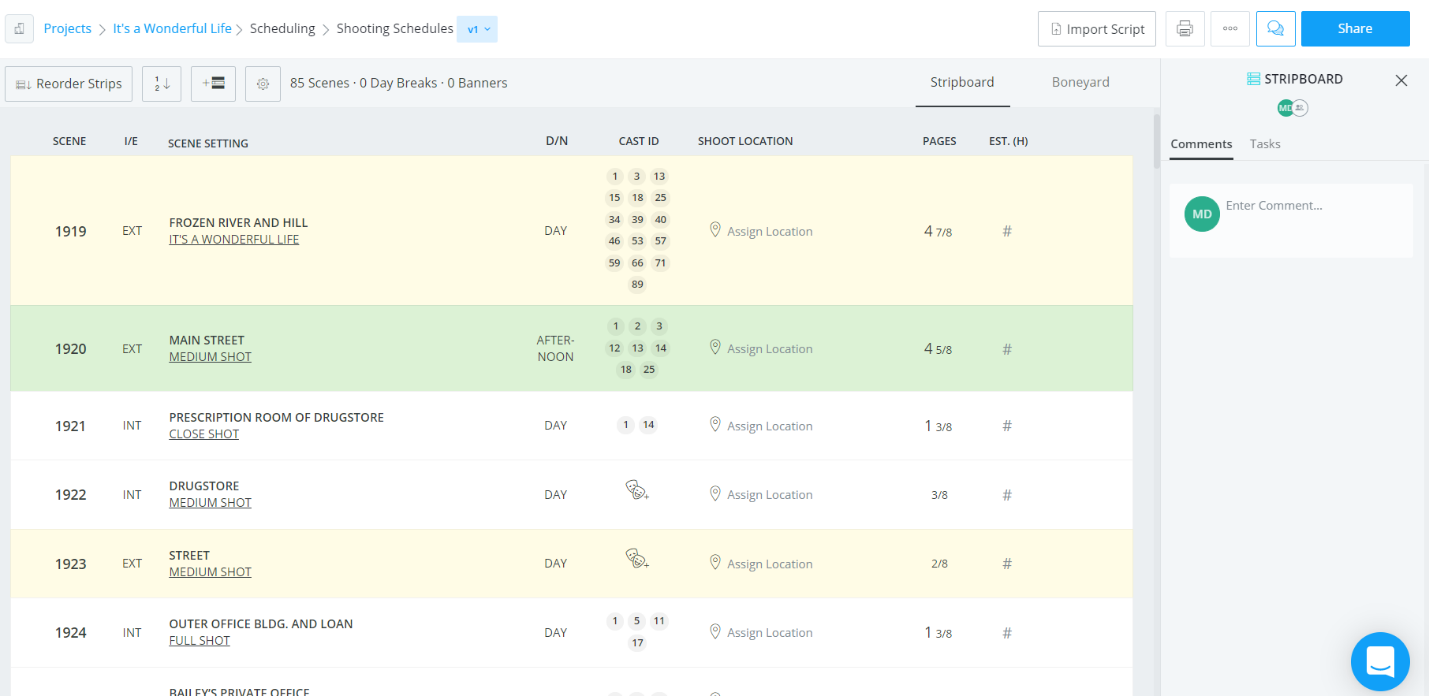If you have been looking for a pre-production project management tool, StudiBinder may be a solution for you. StudioBinder is a project management program targeted toward the pre-production of TV, film and photography projects. This all-in-one platform is browser-based, using cloud computing for both desktop and mobile users. It has been adopted by a variety of indie and corporate content-creators: including BuzzFeed, Spotify, Blizzard Entertainment and NBCUniversal. The main appeal of this program is the ability to breakdown the elements of a script into various pre-production tasks like casting, scheduling, and storyboarding. In order to review the product, I signed up for a free, limited access to the program.
Screenshot image taken of the StudioBinder Project Overview page. Source: Author.
Features
Documents
The documents tab contains a screenwriting tool. It allows you to either import screenplays or to write inside the program. This tool formats writing to the industry standard and can be converted to scripts. The writing can be changed at any time, and the changes will be synced to the rest of the project. It also allows you to tag important elements needed for pre-production, such as settings, effects, and props.
Contacts
The contacts tab allows one to organize the contacts for the project into four groups: crew, talent, extras, and clients. These contacts can be added to custom lists, allowing select people access to different information throughout pre-production. Contacts or import existing contacts can be created in this section.
Workflow/Production Calendar
Workflow: Workflow organizes pre-production tasks into four categories: on hold, in-progress, needs review, and approved. Tasks can be manually inputted into these categories or can be synced from the production calendar.
Production Calendar: This feature is one of the key highlights of this program. It allows to the user to set a timeframe for the entire project, along with pre-production, production, and post-production tasks. It works like a typical project management program, but is equipped with sections and events specific to film, TV and photography production. Each section can be minimized or maximized to hide/show the individual events within the selected section. Events are made by dragging a bar across the desired time frame and can be moved and rearranged easily by clicking and dragging the event to a new slot in the calendar. These events show more information about the event (such as tasks and the time frame) when clicked on.
User Screenshot of the Project Start Screen. Source: Author.
Shooting Scripts
Shooting scripts are broken down into two categories: shooting schedules and script breakdowns.
Shooting Schedules: The program uses a script to automatically create an industry standard shooting schedule, pulling cast, setting, and shot information from the document. It specifies where in the script the scene takes place, the shooting location, cast members needed, and time of day needed per scene. This is another key feature of this program, as it generates accurate shooting information that syncs as changes are made to other pre-production steps in the program. This saves time, as the schedule will not need to be written individually. This schedule can be exported to be shared and printed, making it easily accessible outside the program.
Example of a Production Calendar’s Layout. Source: Screensot by Author
Script Breakdown: The script breakdown imports elements that are tagged throughout the script. The program automatically tags characters, but elements such as special effects, props, stunts, and costumes can be identified as well. This can help organize what elements are needed for each scene, and how frequently they are used throughout the entire script.
Shot Lists/Storyboarding
The program imports scenes from the script and lays them out in a story board. Each scene can be assigned a number of shots, camera movement, and shot type and size. Media can be imported as reference material for each scene, allowing for a visual representation to be used during production and filming.
Call Sheets
This tab generates a call sheet with the information gathered from the script and distributes it to the relevant cast members from the contact list. Recipients can RSVP through text or email after receiving the call list, which notifies the program.
Screenshot Example of a Shooting Schedule. Source: Author.
Pros and Cons
Pros
· Accessible on both mobile and desktop
· Options for small-scale and large-scale productions
· Consistent, industry-standard formatting for all documents
· Aids with collaboration and communication between talent, crew, and clients.
Cons
· Defaults to a pre-set production layout that is time-consuming to customize
· Auto-identification algorithm can misidentify aspects of the script as characters or settings
· Inability to assign tasks to individual team members
· Focused mostly on video production, but tools can be adapted for photography and new media
Plan Options
Individual Plans (One User)
Indie Plan: $29/month
· Manage projects (maximum of 10)
· 50 GB file storage
· Full access:
o Call sheets
o Shot lists/storyboarding
o Shooting schedules
Professional Plan: $49/month
· Manage projects (maximum of 25)
· 75 GB file storage
· Full access:
o Call sheets
o Shot lists/storyboarding
o Shooting schedules
o Script breakdowns
o Production calendar
Studio Plan: $99/month
· Manage projects (unlimited)
· 100 GB file storage
· Full access to all features
Company Plans (Includes All Features)
Agency Plan: $249/month
· 3 users
· Unlimited projects
· Unlimited collaborators
· 200 GB file storage
Production Company Plan: $399/month
· 6 users
· Unlimited projects
· Unlimited collaborators
· 400 GB files
Enterprise Plan: $1,499/month
· Unlimited users
· Unlimited projects
· Unlimited storage
· Enhanced security
· Priority support & onboarding
· Brand white-labeling
· Multi-team management





